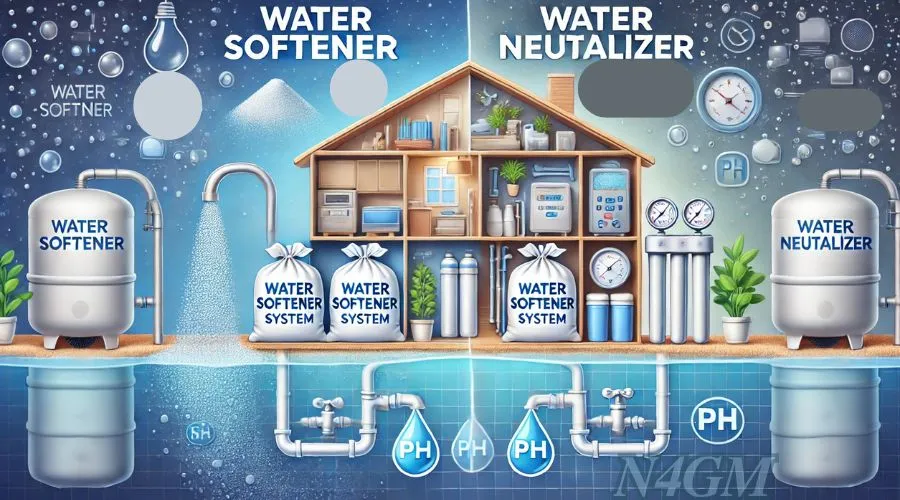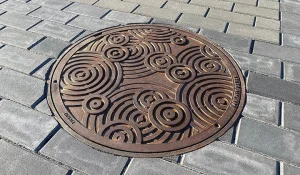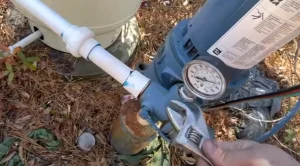Water quality is vital for a healthy lifestyle. It is especially important when dealing with hard water or pH imbalances. These problems often cause buildup in appliances, pipes, and fixtures.
This harms your home’s health. I have lived in a region where groundwater is the main water source. I know the need for better water treatment solutions. Two popular options, water softeners, and water neutralizers, serve distinct purposes. Each addresses specific needs.
While both may sound similar, their differences are significant. Choosing the right system is an informed decision. It depends on your water’s source and its issues. The right choice can make all the difference. It can address a single concern or improve your home’s water quality.
What is a Water Softener?
A water softener is a device. It combats hard water by removing minerals, like calcium and magnesium. These minerals are responsible for scale buildup in pipes, appliances, and fixtures. Hard water affects over 80% of homes worldwide. So, water softeners are vital for treating it.
How Does a Water Softener Work?
Water softeners use ion exchange. They replace calcium and magnesium ions with sodium or potassium ions. Here’s how it works:
- Hard Water Enters the System: Water flows through a resin tank. It contains negatively charged resin beads.
- Ion Exchange Occurs: The resin beads attract and bind calcium and magnesium ions. They are positively charged.
- Soft Water Exits: The water leaving the system is now free from hardness-causing minerals.
- Regeneration Phase: Over time, the resin becomes saturated with hardness minerals. The system flushes the resin with a salt solution to recharge it. This ensures continuous performance.
Benefits of a Water Softener
- Prevents scale buildup in pipes and appliances.
- Enhances the lifespan of water-using devices.
- Improves soap and detergent effectiveness.
- Reduces energy consumption by improving heating efficiency.
- Improves skin and hair health by reducing the dryness caused by hard water.
Types of Water Softeners
- Salt-Based Water Softeners: Use sodium or potassium chloride for ion exchange.
- Salt-Free Water Conditioners: Utilize a physical process to prevent scale but do not remove minerals.
- Dual-Tank Water Softeners: Ideal for large households requiring continuous soft water supply.
What is a Water Neutralizer?
A water neutralizer raises the pH of acidic water to neutral (around 7). Acidic water can cause corrosion in pipes, fixtures, and appliances. This problem is common in areas with high rainfall or soft water.
How Does a Water Neutralizer Work?
Water neutralizers use a tank filled with a neutralizing agent, like calcite or magnesium oxide. As water flows through the tank, the neutralizing agent dissolves. This raises the water’s pH. Some systems may include automatic backwashing to prevent clogging and maintain efficiency.
Benefits of a Water Neutralizer:
- Protects plumbing systems from corrosion.
- Prevents metallic taste in water.
- Reduces leaching of harmful metals like lead and copper into the water.
- Improves water safety for drinking and cooking purposes.
Types of Water Neutralizers
- Calcite-Based Neutralizers: Ideal for mildly acidic water.
- Blended Neutralizers: Combine calcite and magnesium oxide for highly acidic water.
- Chemical Injection Systems: Inject neutralizing chemicals for precise pH adjustment.
Key Differences Between Water Softeners and Water Neutralizers
Understanding the core distinctions between water softeners and water neutralizers is essential for addressing specific water quality issues. Here’s a detailed breakdown of the key differences:
| Feature | Water Softener | Water Neutralizer |
|---|---|---|
| Purpose | Removes hardness (calcium & magnesium) | Neutralizes acidic water (low pH) |
| Main Component | Resin beads for ion exchange | Neutralizing agents (e.g., calcite) |
| Primary Benefit | Prevents scale buildup | Prevents pipe corrosion |
| Effect on Water | Increases sodium or potassium | Balances pH levels |
| Common Issues Addressed | Hard water problems | Acidic water problems |
| Impact on Taste | Slightly salty taste | Removes metallic taste |
| Maintenance Needs | Periodic salt replenishment, resin care | Replenish neutralizing agents |
| Ideal Water Conditions | Hard water with high mineral content | Water with low pH (acidic water) |
| Cost Factors | Moderate initial and upkeep costs | Low to moderate based on water pH |
In-Depth Comparison
1. Target Issues
- Water softeners are primarily designed to address hardness caused by calcium and magnesium. They prevent limescale deposits that damage appliances and reduce water heating efficiency.
- Water neutralizers fix issues caused by acidic water. It can corrode plumbing, stain fixtures, and leach harmful metals, like lead, into the water.
2. Operational Mechanics
- A water softener works by ion exchange. It replaces hardness minerals with sodium or potassium ions.
- A water neutralizer uses a neutralizing agent, like calcite. It dissolves in the water and raises its pH.
3. Installation and Maintenance
- Water softeners need salt added and the resin tank cleaned, regularly.
- Water neutralizers need regular refills of calcite or magnesium oxide. They may also need backwashing for efficiency.
4. Impact on Water Quality
- Softened water may taste slightly salty due to sodium ions, but it’s usually minimal.
- Neutralized water removes metallic taste and prevents corrosion. It does not significantly change mineral content.
5. Compatibility
- Water softeners work best in hard water areas. But, they may not fix low pH issues.
- Water neutralizers suit areas with acidic water. But, they may not fix hard water.
Advanced Considerations for Choosing the Right System
1. Water Composition Analysis
Before choosing a system, conduct a detailed water analysis. Consider hardness, pH, and extra contaminants like iron or chlorine.
2. Combination Systems
In some cases, homes may benefit from a combination of both systems. For example, a household with hard, acidic water might install both a softener and a neutralizer for complete treatment.
3. Cost and Maintenance
- Water Softeners: Require periodic replenishment of salt and resin tank maintenance. Costs vary based on size and type.
- Water Neutralizers: Require occasional replenishment of neutralizing agents and system backwashing. Costs depend on water acidity levels and system capacity.
When to Use a Water Softener?
A water softener is a great solution for hard water in your home. If you see scale on fixtures, a water softener can help. It can also fix reduced water heater efficiency and dry skin or hair after bathing.
It will fix these problems. The system ensures appliances work well, soap lathers and plumbing is free of limescale. Limescale can cause costly repairs.
When to Use a Water Neutralizer?
A water neutralizer is crucial when dealing with acidic water. A pH below 7 in your water can corrode pipes. This may cause leaks and contaminate the water with harmful metals like lead and copper.
This system uses a neutralizing agent to protect your plumbing and fixtures. It also removes the metallic taste in drinking water. This makes it safer and more pleasant to drink.
Common Misconceptions
There are several misunderstandings about water treatment systems. They can cause confusion and poor choices. Many believe a water softener can fix pH imbalances.
This is not true. It’s often assumed that a water neutralizer can remove hardness from water. But, this isn’t its function. Understanding these distinctions is critical to selecting the right system for your needs.
Some common misconceptions include:
- Water softeners and neutralizers are interchangeable. These systems address completely different issues. A water softener combats hard water, while a neutralizer corrects acidic water.
- Softened water is harmful to health due to sodium. The sodium added during the softening process is minimal and generally safe. However, those on low-sodium diets can opt for potassium-based systems.
- Neutralized water has no minerals. A neutralizer does not remove minerals. It simply balances pH levels to prevent corrosion.
- Both systems are high-maintenance. They need upkeep. But, tech advances have made maintenance easier and less frequent.
Actionable Steps to Improve Your Water Quality
- Test Your Water: Purchase a water testing kit or consult a professional.
- Research Options: Explore different brands and models of water softeners and neutralizers.
- Consult Experts: Get tailored advice based on your household’s unique needs.
- Install the System: Hire a professional for installation and setup.
- Maintain Regularly: Ensure periodic maintenance for optimal performance.
- Upgrade When Necessary: Stay updated with the latest technology for better efficiency.
Conclusion:
It’s crucial to know the difference between water softeners and water neutralizers. It helps in fixing water quality issues. Identify your needs and choose the right solution.
It will improve your water quality, protect your appliances, and extend your plumbing’s life. With proper maintenance and smart choices, you can enjoy safe, high-quality water for years.







